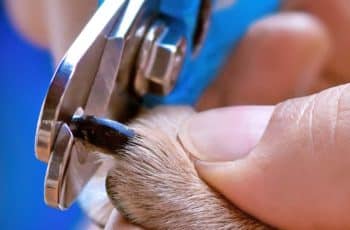Most of the time, if your dog’s nose seems a bit dry, it’s not a big deal. The wetness of a canine nose is a dynamic situation, constantly changing in response to the dog’s hydration and exercise status and the environmental temperature and humidity. Dogs’ noses are always drier when first waking from a nap. Some of the brachycephalic breeds, like Pugs and Shih Tzus, can’t lick their noses very effectively, which means they are always a little on the dry side.
So when should you be concerned about a dry nose? If the appearance of your dog’s nose changes, if your dog seems at all uncomfortable, or if there is nasal discharge. These are all signs that something else may be going on and it’s time to see the vet.
A DRY NOSE IS RELATIVELY BENIGN
Two of the least worrisome conditions that can cause a dry nose are hyperkeratosis and blocked tear ducts.
Hyperkeratosis is a pretty common condition in aging dogs. Keratin is a protein found in hair, skin, and nails. Dog noses contain lots of it. With age, the dog’s normal cell turnover slows and keratin builds up. This results in those crusty, craggy, not-so-pretty noses you sometimes see on geriatric dogs.
While benign, hyperkeratosis can be uncomfortable, so keeping the nose as moisturized as possible is recommended. (See “Effective Moisturizers for Persistently Dry Noses” on the next page for moisturizing product recommendations.)
In some cases, if the buildup gets excessive, your veterinarian may be able to trim back some of the hardened tissue, which will allow your moisturizing agents to work better.
If your dog’s nose is dry and his eyes are watering excessively, he may have blocked tear (nasolacrimal) ducts. This can happen on one side or both. Sometimes mucous can block the inside of an otherwise healthy tear duct. Swelling from surrounding inflammation or infection can occlude a tear duct from the outside. Your veterinarian can confirm tear-duct obstruction by putting a fluorescent stain in the eyes and looking to see if any fluorescence appears at the nostrils. If not, the duct is occluded.
One can aggressively treat this condition by flushing the tear ducts under general anesthesia. Often, because this condition is not harmful and general anesthesia is not without risk, this option is not pursued. However, if your dog has to be anesthetized for something else (such as a dental procedure), consider having the ducts flushed.
Sometimes you can dislodge a mucous plug with repeated, gentle, circular massage under the inside corner of your dog’s eyes.
Your veterinarian may have you try antibiotic ophthalmic steroid drops if infection or swelling is suspected as the underlying cause for the tear-duct obstruction.
Effective Moisturizers for Persistently Dry Noses
- Snout Soother by American Dog Co.
- Solva-ker gel by VetriMax (contains salicylic acid, which is keratolytic)
- Dermoscent BIO BALM
- Musher’s Secret
- Coconut oil
DRY NOSE REASONS OF GREATER CONCERN
More serious causes of a dry nose include infection, dry eye syndrome, autoimmune disease, cancer, and chronic ear infections.
- Infection of the nose or nostrils, called nasal pyoderma or mucocutaneous pyoderma,. can cause dryness, cracking, discomfort, and nasal discharge. It may involve one nostril or both. Treatment is usually oral antibiotics, as it’s tough to effectively treat a nose infection topically due to the dog’s frequent licking. If topical antibiotics are tried, mupiricin is considered the antibiotic of choice.
- If your dog’s nose is dry and he has irritated, dry-looking eyes with excessive, thick mucous discharge, he may have dry eye syndrome (also known as keratoconjunctivitis sicca or KCS). Inadequate tear production due to KCS results in decreased moisture flowing to the nose. There is a simple test for this condition that can be performed right in the exam room. If KCS is confirmed and treated, the dry nose will resolve.
- Pemphigus and discoid lupus erythematous are immune-mediated diseases that can result in a dog’s dry, crusting, cracked, painful nose. Other mucocutaneous junctions on the dog (i.e., eyes, lips, genitals) may also be affected. Diagnosis requires a biopsy. Treatment involves long-term steroids or other immune-suppressive therapies.
- Nasal cancers, like squamous cell carcinoma, will frequently start out looking like a dry, crusty nose. If the nose changes you are seeing get progressively worse, see your veterinarian right away.
- If your dog suffers from chronic ear infections and a dry nose, there could be a connection. Dryness of the nasal mucosa, called xeromycteria, can result from injury to the parasympathetic nerves that innervate the nasal mucosal glands. Because these nerves travel close to the middle ear, inflammation associated with infection of the middle ear (otitis media) can damage these nerves. Otitis media is usually caused by chronic, unresolved external ear infections. To avoid these serious complications, be sure to work with your veterinarian until full resolution of any ear infection is confirmed.
- Allergies sometimes get blamed for causing dry noses in dogs. I don’t know if they do or not, but if they do, successful treatment of the underlying allergy should resolve the problem.
THE BOTTOM LINE ON A DOG WITH DRY NOSE
If your dog develops a dry nose, it’s okay to try things like increasing the humidity in your home and applying a topical moisturizer. But if that dry nose persists, or gets worse, see your veterinarian. Sometimes a dry nose is more than just a dry nose.


